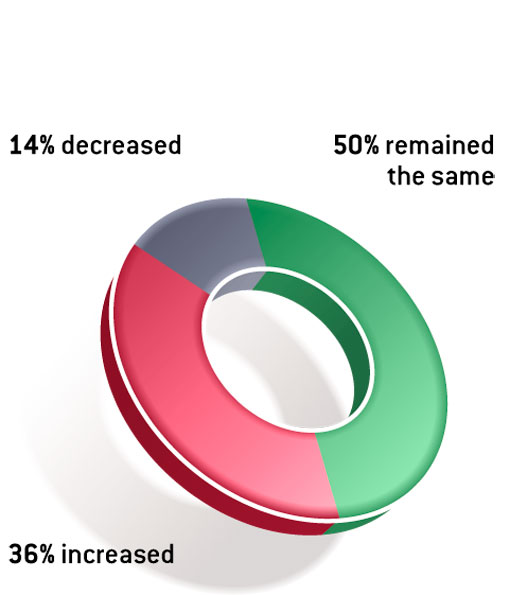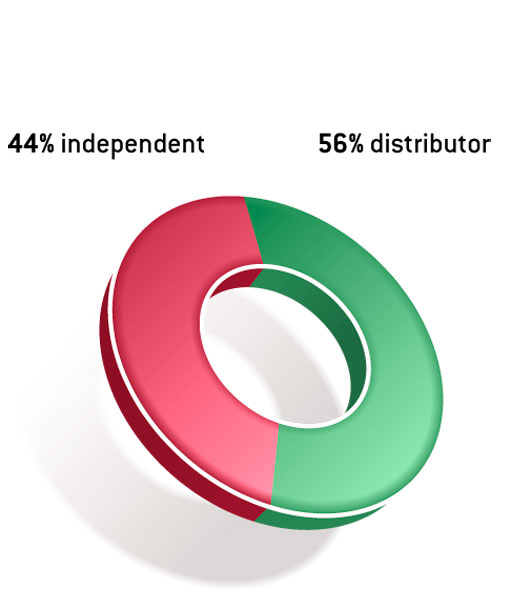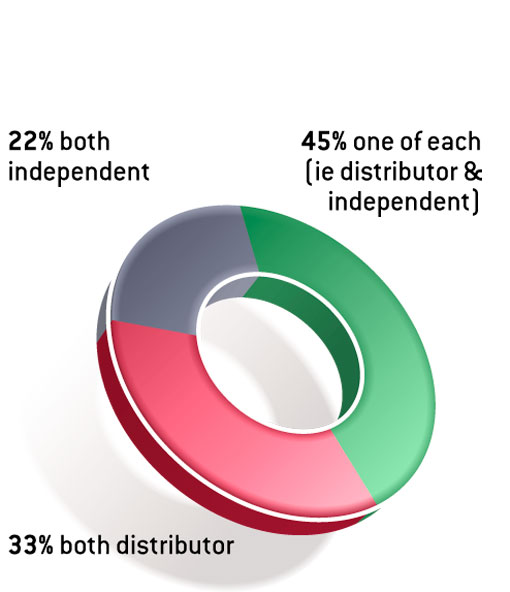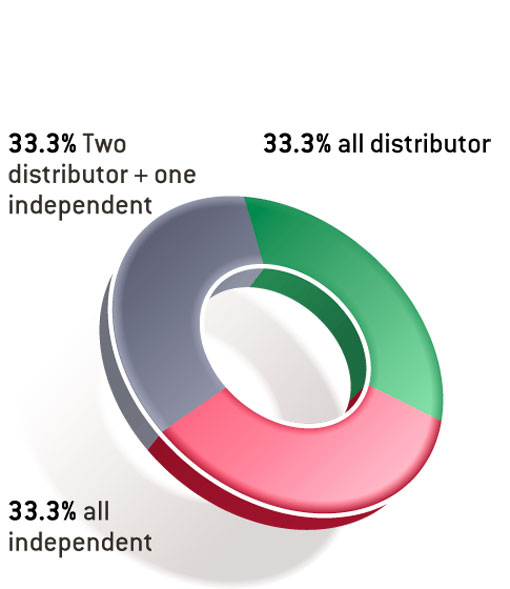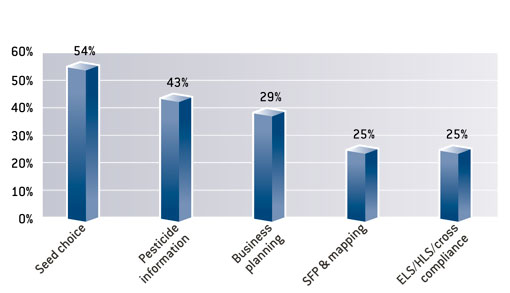Agronomists’ influence increases

The use of advisers has remained unchanged over the past five years for half of growers responding to an exclusive Farmers Weekly straw poll of past and present Barometer Farmers and Farmer Focus writers.
But for the other half, twice as many are employing their agronomists more rather than cutting back on their services – by an average of 24% more, and in one case by 50%. “I spend more time with my agronomist just making sure I am staying within the law,” says Les Anderson, who estimates his Scottish Agronomy adviser is working 15% longer with him than five years ago.
Sandy Walker says an expanded area and more paperwork, for example on ELS and nitrate vulnerable zones is the reason for the 30% increase in his use of two agronomists.
“Other pressures on my time,” is Mike Cumming’s reason for a similar increase.
|
|---|
Tony Reynolds echoes that, pointing to his need for information on new laws and new chemicals.
Robert Stevenson (agronomists’ time up 15%) also cites extra farmed area as does Ben Atkinson who employs three agronomists. “The time’s increased with farm area, but stayed the same per acre,” says the latter.
“Our farmed area has grown,” adds John Barrett (agronomist’s time up 20%). “So I have less time to walk fields.”
Richard Solari says his requirement for more input on potato agronomy explains the 50% increase in his use of agronomists. Ian Pigott believes the 20% increase in his use of his three agronomists’ time highlights his emphasis on precise application of agrochemicals, especially timing.
Less reliant
 |
|---|
Only four respondents say their use of agronomists has declined in five years, and Andrew Charlton’s explanation for a drop of more than 75% is straightforward. “I’ve committed the remaining conventional land to organic and so practically stopped buying inputs.
Nick Davidson estimates that his independent agronomist now spends 40% less time with him than in 2005, mainly because he does all his own crop walking. “I make my own decisions on chemical use based on my own research, and I keep up to speed with pesticide label restrictions and seed varieties on my own,” he explains.
Peter Snell says his independent agronomist’s time spent with him has “decreased in acreage terms” but by how much is unclear. “He visits fortnightly, but now does an increasing acreage. Plus with me becoming more experienced/qualified [he hopes to become BASIS-qualified this winter] I tend to do some of the field walking/decisions.”
BASIS qualified
Only 11 of our 31 respondents are BASIS-qualified. They include Andy Barr whose independent agronomist’s time on his farm is down by 90% since 2007. “I did have a full agronomy service until three years ago. But I decided I’d like to get qualified and have a go myself to increase my understanding of the whole subject.
“I’ve enjoyed learning more about agronomy and I think sometimes it helps me see a more complete picture of crop production. But with increasing time constraints I don’t suppose I’ll do it for ever.”
No agronomists
Growers only having one agronomist |
|---|
Philip Bradshaw is also BASIS-qualified and has not employed an agronomist for three years. “On my own land I’ve gained experience and now do my own agronomy with strategic advice from seminars and specific advice from manufacturers, distributors and others within the industry.
Growers having two agronomists |
|---|
“It’s a challenge to keep up to date, particularly with label restrictions and changes, and to regularly inspect fields as necessary in busy periods.
“Northern Ireland lacks experienced agronomists,” says Allan Chambers who does not employ one. “Hopefully, this will improve with the arrival of UAP.”
Independent v distributor
Agronomy advice to Farmers Weekly Barometer Farmers and Farmer Focus writers comes marginally more from distributors than independent sources, according to the poll. Of the total of 42 agronomists employed, 22 come from distributors.
Growers having three agronomists |
|---|
Will Howe says his agronomist works for a distributor, but independently for him. “I buy my chemicals from any company,” he explains.
Of the 16 respondents with a sole agronomist, nine are from distributors.
Andrew Blenkiron relies on one independent – “an invaluable member of the team. It’s very useful to have another pair of eyes looking over fields, especially at peak time, bringing with them the knowledge and experience gained from other parts of the county/country.”
Nine respondents employ two agronomists, spread almost equally between both sources, four using one of each. Andrew Symonds uses a distributor agronomist for potato agronomy, but an independent for other crops. “I know some of it,” he comments. “But they specialise and can keep up-to-date better than I can. They’re certainly valuable.”
Only three farmers in our poll use as many as three agronomists. Mr Atkinson’s are all from distributors and Mr Pigott’s are all independent, as is one of Mr Reynolds’ trio.
Over the past few years very few husbandry decisions have been taken without conversation with them, says Mr Reynolds. “We have one for each farm, which works well, gives me some alternative views and keeps the job competitive.”
Discussion is the norm
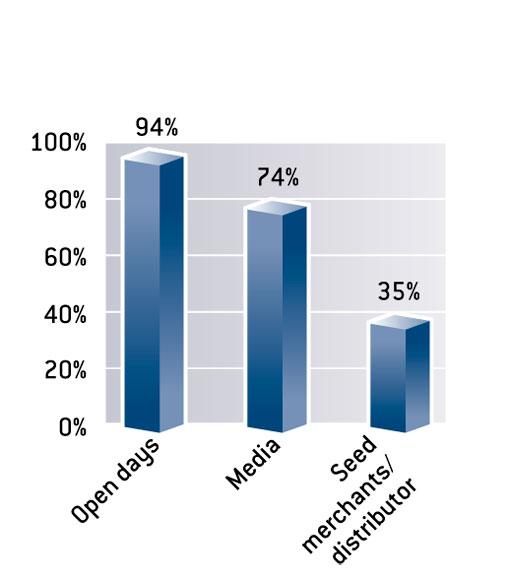 Growers’ main extra sources of crop management advice |
|---|
Only two poll respondents, Edward Tupper and Neil Thomson, say they rely totally without question on their agronomists. Two-thirds do so “to a large extent”, but a quarter “only after considerable debate”.
Sitting in the “to a large extent” category are Mr Blenkiron: “There’s no point in paying someone for their expertise if you know better than them,” and Mr Snell: “That’s what he’s paid for.”
Mr Howe says he also relies “to a large extent”, “but only after debate and me playing the Jeremy Paxman role, questioning everything.”
Paul Temples relies “reasonably heavily” on his distributor agronomist. “We still debate, but he has been walking the farm for nearly 30 years.”
Mr Barr, who receives telephone advice from Crop Advisors’ buying group, says: “I collate advice from various sources, add my own experience, practical and cost implications and make a decision. I will consult and follow advice when I don’t know the answer.”
Other services
75% use agronomists for other services including:
|
|---|
Three-quarters of our poll respondents employing agronomists do so for more than managing crops with about half (53%) consulting them on seed choice. Their next most popular service (43%) is providing up-to-date information on pesticide label restrictions.
Mr Blenkiron finds it useful to ensure he has no “out-of-date” products in store. “I listen to what he has to say about varieties, but don’t necessarily take that much notice.”
Roughly a quarter also employ them for filling in SFP forms and mapping, helping with ELS/HLS and cross compliance, and business planning.
“With legislation moving so fast, it’s hard to keep up,” says Mr Howe. “For a professional job to be done, I need a professional.
“I have contemplated doing my BASIS on numerous occasions; but my interest is not in plant physiology, and I know the agronomy side would suffer when we’re busy drilling and spraying.
“My main aim is to get the land worked and crops planted to the best of my ability for the agronomist to then come in and use their expertise to take the crops to the next level.”

